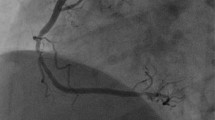Summary
The feasibility and safety of coronary endoscopy was evaluated in three sets of investigations: in 7 cadaver hearts, in 11 patients undergoing coronary bypass surgery, and in 30 patients during routine cardiac catheterization prior to coronary balloon angioplasty (PTCA). In three of the seven cadaver hearts the lumen of the arteries appeared normal. In three diffuse atherosclerotic lesions, and in one, a high-grade, tight stenosis were observed. In nine of eleven patients in the operation room, the lesions of interest could be visualized, and high-grade stenoses were found in all. In addition, in three patients with unstable angina pectoris, fresh thrombi were seen at the site of stenosis. In six of the nine patients, the periphery of the native coronary vessel was found to have no further stenotic regions. During cardiac catheterization in 17/30 patients, the lesion of interest could be examined angioscopically, and in 13 instances the stenosis appeared excentric and irregularly shaped. In three instances, multiple ulcerations were seen in the stenotic area. In two of the five patients, intimal ruptures were found following PTCA, which could not be documented angiographically. Coronary endoscopy provides valuable additional information on the nature and appearance of atherosclerotic lesions. It can be performed clinically without great harm to the patients. Despite some limitations, it will probably become a routine diagnostic tool in patients undergoing routine coronary angiography, balloon angioplasty or high-frequency angioplasty, and coronary bypass grafting.
Similar content being viewed by others
References
Brown BG, Petersen RB, Pierce CD, Bolson EL, Dodge HT (1983) Arteriographic assessment of coronary disease: advantages, limitations, and clinical uses of a computer-assisted method. In: Rapaport E (ed) Cardiology update, reviews for physicians. Elsevier Biomedical Press, New York Amsterdam Oxford, p 67
Cutler EC, Levine SA, Beck CS (1924) The surgical treatment of mitral stenosis. Experimental and clinical studies. Arch Surg 9: 689
Greenstone SM, Shore JM, Heringman EC, Massell TB (1966) Arterial endoscopy (arterioscopy). Arch Surg 93: 811
Hombach V, Höher M, Hannekum A, Hügel W, Buran B, Höpp HW, Hirche H (1986) First clinical experiences with coronary endoscopy. Dtsch Med Wochenschr 111: 1135
Hombach V, Höher M, Arnold G, Osypka P, Kochs M, Eggeling T, Höpp HW, Hirche H, Hilger HH (1987) High frequency angioplasty — a new method for recanalization of occluded arterial vessels. CorVas 2: 67
Lichtlen PR (1979) Koronarangiographie. Perimed, Erlangen
Litvack F, Grundfest WS, Lee ME, Carroll RM, Foran R, Chaux A, Berci G, Rose HB, Matloff JM, Forrester JS (1985) Angioscopic visualization of blood vessel interior in animals and in humans. Clin Cardiol 8: 65
Litvack F, Hickey A, Grundfest W, Lee M, Sherman T, Doyle L, Chaux A, Blanche C, Kass R, Matloff J, Swan JHC, Forrester J (1986) Angioscopy is superior to angiography for detecting complex atheroma. Circulation [Suppl II] 74: II-362
Reiber JHC, Gerbrands JJ, Kooijman CJ, Troost GJ, Schuurbiers JCH, Slager CJ, Boer A den, Serruys PW (1983) Computer-aided analysis of coronary obstructions from monoplane cineangiograms and three-dimensional reconstruction of an arterial segment from two orthogonal views. In: Short MD, Pay DA, Leeman S, Harrison RM (eds) Physical techniques in cardiovascular imaging. Hilger, Bristol, p 173
Sherman CT, Litvack F, Grundfest WS, Lee M, Hickey A, Chaux A, Kass R, Blanche C, Matloff J, Morgenstern L, Ganz W, Swan JHC, Forrester JS (1986) Demonstration of thrombus and complex atheroma by in vivo angioscopy in patients with unstable angina pectoris. N Engl J Med 315: 913
Spears JR, Spokojny AM, Marais JH (1985) Coronary angioscopy during cardiac catheterization. JACC 6: 93
Vollmar JF, Stortz LW (1974) Vascular endoscopy. Possibilities and limits of its clinical application. Surg Clin North Am 54: 111
Author information
Authors and Affiliations
Rights and permissions
About this article
Cite this article
Hombach, V., Höher, M., Höpp, HW. et al. The clinical significance of coronary angioscopy in patients with coronary heart disease. Surg Endosc 2, 1–4 (1988). https://doi.org/10.1007/BF00591390
Issue Date:
DOI: https://doi.org/10.1007/BF00591390




